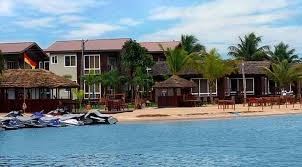The district's coconut palm fringed coastline is 45 kilometers long and provides a living to many people that are employed in fishing and fish processing. However, this coastline is constantly being eroded by the strong tidal waves that are washing away or threatening several villages that are located close to the beach. In order to solve this problem, the construction of a sea defense wall is under way since 2010.
The long, sandy beaches are certainly some of the most important tourist attractions. However, there are certain obstacles such as the lack of toilets in the villages close to the beach and the consequence of using the beach as such. Also, garbage – mostly plastic – is piling up at the beach, some of it disposed there, some washed up from the sea by the tide.
Apart from the sandy beaches, another natural attraction in the district is the Volta River and its estuary. The Volta River forms the eastern boundary of the district before it reaches the Gulf of Guinea. The islands in the river and in the estuary are a wildlife paradise: marine turtles, birds, crocodiles and monkeys are some of the animals living there. The mangrove vegetation in the salty parts of the estuary is another attraction and an important ecosystem. It is however endangered by human activity along with rare animals that are often hunted down.
The estuary also offers the best conditions for water sports like sailing, canoeing, fishing, water skiing, wake boarding and jet skiing.
Another important water body and one of the most important salt mining areas in the country is the Songor Lagoon. Additional to visiting it and learning about salt mining it serves as a base for birdwatchers
Beautiful post
looks great!
Hi! I am a robot. I just upvoted you! I found similar content that readers might be interested in:
https://en.wikipedia.org/wiki/Dangme_East_District